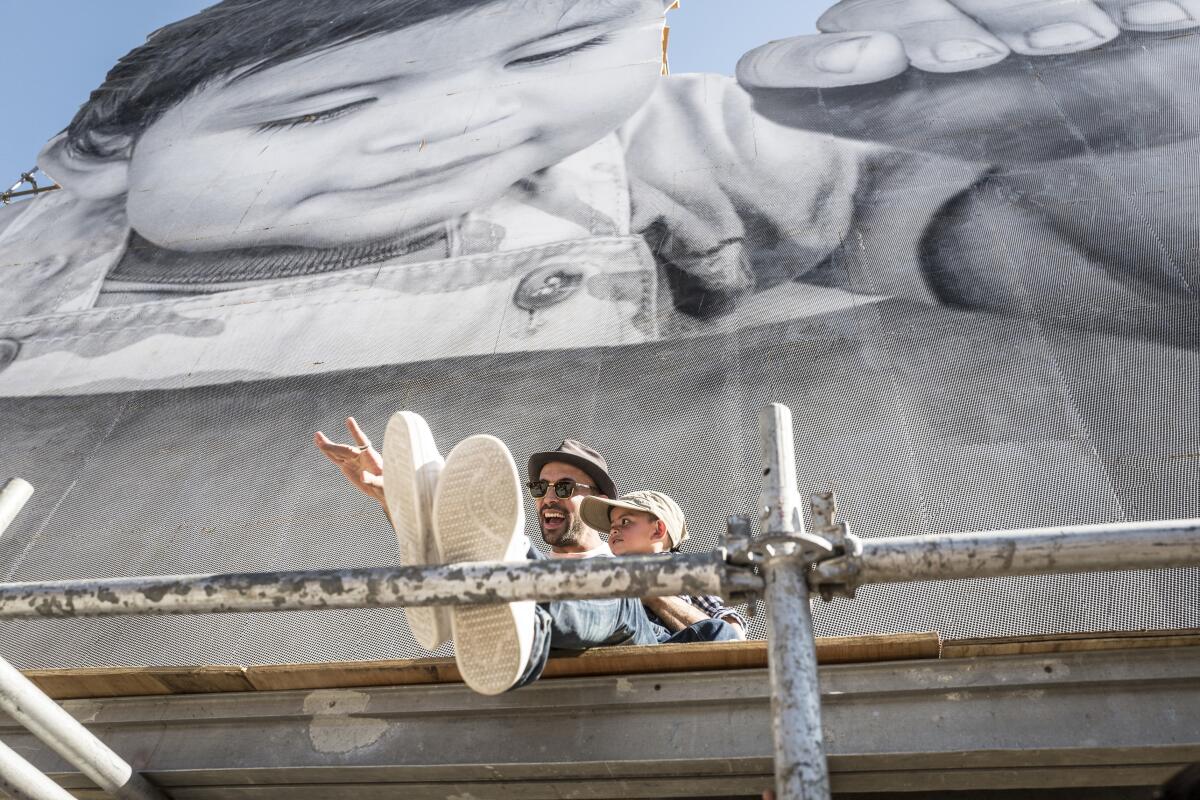Review: French artist JR reveals the faces behind the walls and landscapes in ‘Paper & Glue’

- Share via
The Times is committed to reviewing theatrical film releases during the COVID-19 pandemic. Because moviegoing carries risks during this time, we remind readers to follow health and safety guidelines as outlined by the Centers for Disease Control and Prevention and local health officials.
French artist and filmmaker JR’s documentary “Paper & Glue” opens with a quote from Agnès Varda, his collaborator on the Oscar-nominated documentary “Faces Places.” Her words, in simple white text, read: “If we opened people up, we’d find landscapes.” At the end of the film, JR adds his own spin on that idea, saying: “Behind all landscapes, behind all walls, are people” — his thesis, or a manifesto of sorts.
Combining portraiture and landscapes is a practice he’s returned to again and again in his public artworks, an almost compulsive papering of walls with faces, eyes and people.
JR is a self-described photograffeur (a portmanteau of “photographer” and “graffeur,” the French word for a graffiti artist) from the suburbs of Paris who got his start tagging buildings and gradually moved on to photography after finding a camera in a Métro station.
Though JR hides his identity behind his signature clubmaster shades and his work comes from the shadowy, pseudonymous world of street art, that art is rooted in the process of interpersonal connection and exchange. It’s a collectivist pursuit of creating and interacting with art in public, especially among marginalized communities, which is beautifully laid out in “Paper & Glue.”
In the film, he looks at five of his most iconic installations, relayed via casual anecdotes nested inside the process of creating other projects. While JR is visiting a supermax prison near Tehachapi, Calif., and enlisting its inmates to participate in one of his projects, he describes an installation he created at the U.S.-Mexico border: A giant photograph of a toddler, Kikito, peering over the fence from the Mexican side. It became a social media sensation, and when the scaffolding the photo was attached to needed to come down, JR threw a party with tacos and a band that erased the border for a moment.
After installation of a group portrait on the blood and tear gas-stained yard at the prison is complete (though the effects of this collective art process continue to resonate through these inmates’ lives), JR takes the narrative back to 2003, to the place where he transformed from “graffeur” to “artist”: the Bosquets projects in the Paris suburb of Montfermeil.
Exploring this far-flung neighborhood, and meeting and photographing its residents and pasting their likenesses on the buildings was a way to humanize the neglected space, a mission that crystallized after riots exploded there in 2005, when police killed two teenage boys. One of JR’s closest friends and collaborators from Les Bosquets is Ladj Ly, who captured footage of the rioters, and whose 2019 film depicting the events, “Les Misérables,” won the Cannes jury prize and was nominated for an Oscar. JR later put up silly close-up portraits around Paris of the young men from Les Bosquets, challenging the image established by the mainstream media.
The art school that JR and Ladj founded in Les Bosquets leads to yet another anecdote, about the time JR traveled to a violent Brazilian favela to paste images of the eyes of the community’s women on the walls of their houses, the matriarchs looking down on their vulnerable children. It’s not just the creation of this art that makes it so powerful but also the community participation, recognition and respect they receive from him.
“Paper & Glue” is a larger look at the work JR did with Varda in “Faces Places,” and there are connections to be made to artists like Banksy and Shepard Fairey, but fundamentally, this is a way for JR to declare his own artistic statement. It’s not just about his own art or the finished product (which is temporary, decomposing, weather-beaten, scraped and washed away). The juice is in the process, a notion he’s astonished to witness the California inmates pick up so quickly. The power of his art is in the way he sees people, creating canvases for them to be seen, to exist, for a moment, larger than life; portrait as landscape big enough to be seen by all, something especially meaningful for those so often overlooked. When JR turns his gaze toward a person and pastes their image on a wall, he’s inviting others not just to participate in this project but also to look their way, to pay attention to someone or something by seeing it differently in the world. It takes a village, but all they need is paper and glue.
‘Paper & Glue’
Not rated
Running time: 1 hour, 34 minutes
Playing: Starts Nov. 19, Laemmle Monica, Santa Monica; Laemmle Glendale
More to Read
Only good movies
Get the Indie Focus newsletter, Mark Olsen's weekly guide to the world of cinema.
You may occasionally receive promotional content from the Los Angeles Times.










